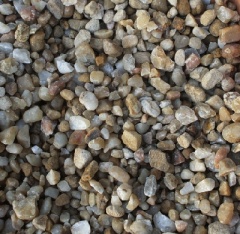Quartz
| Infobox on Quartz | |
|---|---|
| Example of Quartz |  |
| Facts | |
| Origin | - |
| Stowage factor (in m3/t) | 0,60 m3/t |
| Humidity / moisture | - |
| Ventilation | No special requirements |
| Risk factors | See text |
Quartz
Description / Application
Quartz is the second most abundant mineral in the Earth's continental crust, after feldspar. It is made up of a continuous framework of SiO4 silicon–oxygen tetrahedra, with each oxygen being shared between two tetrahedra, giving an overall formula SiO2.
There are many different varieties of quartz, several of which are semi-precious gemstones. Especially in Europe and the Middle East, varieties of quartz have been since antiquity the most commonly used minerals in the making of jewelry and hardstone carvings.
Physical Properties of Quartz
| Colour | Clear (in pure form) |
| Streak | White |
| Melting point | 1650 (approx. 75) °C. |
| Boiling point | 2230°C. |
| Solubility | H20 insoluble |
Major Varieties of Quartz
- Chalcedony - Any of the cryptocrystalline quartz, although usually only used for white or lightly coloured material.
- Agate - Banded Chalcedony, translucent.
- Onyx - Agate, where bands are straight, parallel and also consistent in size.
- Jasper - Opaque chalcedony, impure.
- Aventurine - Translucent chalcedony with a smaller inclusions (generally mica), which shimmer.
- Tiger's Eye - Fibrous quartz, exhibiting chatoyancy.
- Rock Crystal - Clear, colorless.
- Ruby Quartz - Crimson glass-like crystal that absorbs vast amounts of solar energy.
- Amethyst - Purple, transparent.
- Citrine - Yellow to reddish orange, greenish yellow.
- Rose Quartz - Pink, translucent, might display diasterism.
- Milk Quartz or Snow Quartz - White, translucent to opaque, may display diasterism.
- Smoky Quartz - Brown, transparent.
- Morion - Dark-brown, opaque.
- Carnelian - Reddish orange chalcedony, translucent
Uses of Quartz
- Silica for glass
- Electrical components
- Optical lenses
- Abrasives
- Gemstones
- Ornamental stone
- Building stone
- Piezoelectricity - It creates electricity through a process known as piezoelectricity with mechanical stress given on it. Earlier, quartz crystal was uses as phonograph pickup. Now, it is used as crystal oscillator. These oscillators are simply known as "quartzes."
Occurrences of Quartz
- Amethyst - Brazil, Uraguay, Mexico, Russia, Thunder Bay area of Canada, and some localities in the US.
- Smoky Quartz - Brazil, Colorado, Scotland, Swiss Alps and many other places.
- Rose Quartz - It is widespread but large quantities come from Brazil.
- Natural Citrine - It is found with many amethyst deposits but in a very rare quantities.
- Rock Crystal - Brazil, Arkansas, many localities in Africa, etc.
- Fine Agates - Brazil, Lake Superior region, Montano, Mexico and Germany.
See also Minerals
Shipment / Storage
Quartz description: crystalline lumps.
No special hazards. This cargo is non-combustible or has a low fire-risk.
For overseas carriage consult the IMSBC Code (International Maritime Solid Bulk Cargoes Code) and applicable MSDS sheet.
Risk factors
Avoid inhalation of fine particles. TLV: (for respirable dust) 10 mg/m3% respirable quartz + 2.











